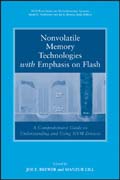
Nonvolatile memory technologies with emphasis on Flash: a comprehensive guide to understanding and using Flash memory devices
Brewer, Joseph E.
Gill, Manzur
Presented here in this work is an all-inclusive treatment of Flash technology, including Flash memory chips, Flash embedded in logic, binary cell Flash, and multilevel cell Flash. The book begins with a tutorial of elementary concepts to orient readers who are less familiar with the subject. Next, it covers all aspects and variations of Flash technology at a mature engineering level: basic device structures, principles of operation, related process technologies, circuit design, overall design tradeoffs, device testing, reliability, and applications. INDICE: Foreword. Preface. Contributors. 1 INTRODUCTION TO NONVOLATILE MEMORY (Joe E. Brewer). 1.1 Introduction. 1.2 Elementary Memory Concepts. 1.3 Unique Aspects of Nonvolatile Memory. 1.4 Flash Memory and Flash Cell Variations.1.5 Semiconductor Device Technology Generations. 2 FLASH MEMORY APPLICATIONS (Gary Forni, Collin Ong, Christine Rice, Ken McKee, and Ronald J. Bauer). 2.1 Introduction. 2.2 Code Storage. 2.3 Data Storage. 2.4 Code+Data Storage. 2.5 Conclusion. 3 MEMORY CIRCUIT TECHNOLOGIES (Giulio G. Marotta, Giovanni Naso, and Giuseppe Savarese). 3.1 Introduction. 3.2 Flash Cell Basic Operation. 3.3 Flash Memory Architecture. 3.4 Redundancy. 3.5 Error Correction Coding (ECC). 3.6 Design for Testability (DFT). 3.7 Flash-Specifi c Circuit Techniques. 4 PHYSICS OF FLASH MEMORIES (J. Van Houdt, R. Degraeve, G. Groeseneken, and H. E. Maes). 4.1 Introduction. 4.2 Basic Operating Principles and Memory Characteristics. 4.3 Physics of Programming and Erase Mechanisms. 4.4 Physics of Degradation and Disturb Mechanisms. 4.5 Conclusion. 5 NOR FLASH STACKED AND SPLIT-GATE MEMORY TECHNOLOGY (Stephen N. Keeney, Manzur Gill, and David Sweetman). 5.1 Introduction. 5.2 ETOX Flash Cell Technology. 5.3 SST SuperFlash EEPROM Cell Technology. 5.4 Reliability Issues and Solutions. 5.5 Applications. 6 NAND FLASH MEMORY TECHNOLOGY (Koji Sakui and Kang-Deog Suh). 6.1 Overview of NAND EEPROM. 6.2 NAND Cell Operation. 6.3 NAND Array Architecture and Operation. 6.4 Program Threshold Control and Program Vt Spread Reduction. 6.5 Process and Scaling Issues. 6.6 Key Circuits and Circuit/Technology Interactions. 6.7 Multilevel NAND. 7 DINOR FLASH MEMORY TECHNOLOGY (Moriyoshi Nakashima and Natsuo Ajika). 7.1 Introduction. 7.2 DINOR Operation and Array Architecture. 7.3 DINOR Technology Features. 7.4 DINOR Circuit for Low-Voltage Operation. 7.5 Background Operation Function. 7.6 P-Channel DINOR Architecture. 8 P-CHANNEL FLASH MEMORY TECHNOLOGY (Frank Ruei-Ling Lin and Charles Ching-Hsiang Hsu). 8.1 Introduction. 8.2 Device Structure. 8.3 Operations of P-Channel Flash. 8.4 Array Architectureof P-Channel Flash. 8.5 Evolution of P-Channel Flash. 8.6 Processing Technology for P-Channel Flash. 9 EMBEDDED FLASH MEMORY (Chang-Kiang (Clinton) Kuo andKo-Min Chang). 9.1 Introduction. 9.2 Embedded Flash Versus Stand-Alone Flash Memory. 9.3 Embedded Flash Memory Applications. 9.4 Embedded Flash Memory Cells. 9.5 Embedded Flash Memory Design. 10 TUNNEL DIELECTRICS FOR SCALED FLASH MEMORY CELLS (T. P. Ma). 10.1 Introduction. 10.2 SiO2 as Tunnel Dielectric-Historical Perspective. 10.3 Early Work on Silicon Nitride as a Tunnel Dielectric. 10.4 Jet-Vapor Deposition Silicon Nitride Deposition. 10.5 Properties of Gate-Quality JVD Silicon Nitride Films. 10.6 Deposited Silicon Nitride as Tunnel Dielectric. 10.7 N-Channel Floating-Gate Device with Deposited Silicon Nitride Tunnel Dielectric. 10.8 P-Channel Floating-Gate Device with Deposited Silicon Nitride Tunnel Dielectric. 10.9 Reliability Concerns Associated with Hot-Hole Injection. 10.10 Tunnel Dielectric for SONOS Cell. 10.11 Prospects for High-K Dielectrics. 10.12 Tunnel Barrier Engineering with Multiple Barriers. 10.13 Summary. 11 FLASH MEMORY RELIABILITY (Jian Justin Chen, Neal R. Mielke, and Chenming Calvin Hu). 11.1 Introduction. 11.2 Cycling-Induced Degradations in Flash Memories. 11.3 Flash Memory Data Retention. 11.4 Flash Memory Disturbs. 11.5 Stress-Induced Tunnel Oxide Leakage Current. 11.6 Special Reliability Issues for Poly-to-Poly Erase and Source-Side Injection Program. 11.7 Process Impacts on Flash Memory Reliability. 11.8 High-Voltage Periphery Transistor Reliability. 11.9 Design and System Impacts on Flash Memory Reliability. 11.10 Flash Memory Reliability Screening and Qualifi cation. 11.11 For Further Study. 12 MULTILEVEL CELL DIGITAL MEMORIES (Albert Fazio and Mark Bauer). 12.1 Introduction. 12.2 Pursuit of Low-Cost Memory. 12.3 Multibit Storage Breakthrough. 12.4 Viewof MLC Today. 12.5 Low-Cost Design Implementation. 12.6 Low-Cost Process Manufacturing. 12.7 Standard Product Feature Set. 12.8 Further Reading: MultilevelFlash Memory and Technology Scaling. 12.9 Conclusion. 13 ALTERNATIVE MEMORY TECHNOLOGIES (Gary F. Derbenwick and Joe E. Brewer). 13.1 Introduction. 13.2 Limitations of Flash Memory. 13.3 NROM Memories. 13.4 Ferroelectric Memories. 13.5 Magnetic Memories. 13.6 Single-Electron and Few-Electron Memories. 13.7 Resistive and Hybrid CMOS/Nanodevice Memories. 13.8 NOVORAM/FRAM Cell and Architecture. 13.9 Phase Change Memories. Index. About the Editors.
- ISBN: 978-0-471-77002-2
- Editorial: John Wiley & Sons
- Encuadernacion: Cartoné
- Páginas: 792
- Fecha Publicación: 01/02/2008
- Nº Volúmenes: 1
- Idioma: Inglés
